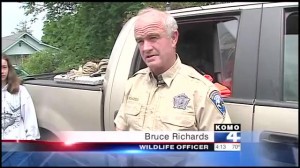The city of Issaquah deserves high marks and praise for including bear resistant containers as part of their contract negotiaions for selecting a waste management company. Effective July 1, 2012 CleanScapes will offer Issaquah residents the BearSaver toters for garbage, compost/yard waste and recycling. Read more.
Agencies
First time “hard release” of a cougar in Washington
A 140-pound male cougar was too close for comfort, hanging around homes and a school near Enumclaw. The Washington Department of Fish and Wildlife trapped the animal and then “hard released” the cougar using Karelian Bear Dogs and shooting bean bags to scare the animal away so it won’t return to the neighborhood. Fish and Wildlife officers fitted the cougar with a radio collar which will monitor its whereabouts.
There are approximately 2,000 cougars in Washington State. To learn more about cougars and co-existing with them visit GBOP’s website
Fifth Washington Wolf Pack Confirmed
Washington Department of Fish and Wildlife Press Release:
July 22, 2011
Contact: Harriet Allen, (360) 902-2694
State’s fifth wolf pack confirmed in Stevens County
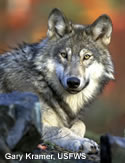 OLYMPIA—Washington’s fifth gray wolf pack has been confirmed in northeast Stevens County.
OLYMPIA—Washington’s fifth gray wolf pack has been confirmed in northeast Stevens County.
Earlier this month, Washington Department of Fish and Wildlife (WDFW) biologists caught, marked with an ear tag and released a 2-month-old wolf pup from the pack. Biologists have since been trying to capture one of the pack’s breeding adult wolves to radio-collar it for monitoring. The effort to document the pack began after local ranchers reported observing three wolf pups and hearing howling in late June.
The pack is believed to include a breeding-age male and female and at least three pups. The group has been named the Smackout Pack, in reference to geographic features in the area.
The Lookout Pack, confirmed in Okanogan and Chelan counties in 2008, was Washington’s first documented resident gray wolf pack since a breeding population of wolves was extirpated from the state in the 1930s. Two more packs have been documented in Pend Oreille County—the Diamond Pack was confirmed in 2009, and the Salmo Pack was confirmed in 2010.
Last month, the state’s fourth documented pack—dubbed the Teanaway Pack— was confirmed in Kittitas County. DNA analysis of that pack’s adult female wolf indicated she is likely a recent descendant of the Lookout Pack.
The gray wolf (Canis lupus) is protected throughout Washington as a state endangered species. In the western two-thirds of Washington, the species is also federally protected under the Endangered Species Act (ESA). It is illegal to harm or harass a federal- or state-protected endangered species.
WDFW has been working since 2007 to develop a wolf conservation and management plan in anticipation of wolves re-entering Washington from other states or Canada.
A Final EIS/recommended plan—which was developed with a 17-member citizen group and included extensive public review and scientific peer review—will be presented to the Washington Fish and Wildlife Commission in a special public meeting Aug. 4 in Olympia. Additional public workshops on the proposed plan are scheduled later this summer and in the fall.
“Wolves are re-establishing here on their own,” said Nate Pamplin, who heads WDFW’s Wildlife Program. “The confirmation of additional breeding wolf packs moves us closer to achieving a sustainable population, and also highlights the need to finalize a state wolf plan that sets recovery targets and management tools to address livestock and ungulate conflicts.”
More information on the draft plan and all Washington wolf packs.
Wolf sightings or activity should be reported through the joint federal-state toll-free wolf reporting hotline at 1(888) 584-9038. Joint federal-state Wolf Response Guidelines, including agency staff contact information, are available at here.
White family charged with killing up to five gray wolves
Bill and Tom White are alleged to have killed a total of five endangered gray wolves on or near their Twisp, Washington property in the area that the Lookout Pack had established residence.
One of the wolves shot by the Whites in 2008 was skinned and the hide attempted to be smuggled to Canada for processing. The package was intercepted when it started leaking blood at the FedEx office in Omak. This incident kicked off the federal investigation into the Whites, whose homes were searched by state and federal agents.
The U.S. District Court in Spokane indicted Bill White, his son Tom White and Tom’s wife, Erin White with conspiracy to take an endangered species, punishable by up to one year in prison and up to $100,000 in fines, and smuggling a wolf hide out of the country, punishable by up to 10 years in prison and fines.
The Lookout Pack is the first pack of gray wolves confirmed in Washington in more than 70 years. In July 2008 there were as many as nine animals in eastern Washington, but state wildlife officials fear that because of poachers as few as two animals have survived.
Read more about the killing of gray wolves in Methow Valley.
To learn more about gray wolves visit GBOP’s website
Sow and two juveniles seek refuge in a cedar tree
This past Saturday a resident form Sammamish notified me of three bears hanging out in her neighbor’s tree. I quickly turned my car around and headed to her house. When I arrived, there were five people in the street, heads up, staring at a 70 foot cedar tree. I knew the bears had to be in that tree, but they were barely visible. Soon my eyes picked out the three black spots hidden in the branches. The resident who called me explained that the bears broke into her neighbor’s chicken coop and ate a few chicks. Fish and Wildlife was called to set a trap next to the chicken coop.
I found out the neighbor has lived in this Sammamish neighborhood for seven years and never saw bears until last year when construction began nearby on a new subdivision. She believes this same sow was spotted last summer rummaging through garbage and feeding on bird feeders. Following these incidents, the entire neighborhood worked together to remove attractants and keep garbage stored inside until the morning of garbage pick-up. Unfortunately, the allure of the chickens was too great for the sow to resist. I gave the neighbor information about electric fencing the coop and also reminded her to remove ripe or fallen fruit from her apple trees.
For more tips on coexisting with bears visit GBOP’s website.
Wenatchee climate change workshop
The Okanogan-Wenatchee NF hosted the most recent climate change workshop for the North Cascadia Adaptation Partnership (NCAP) on February 23, 2011 in Wenatchee. NCAP is a Forest Service (FS) and National Park Service (NPS) collaboration on climate change adaptation. NCAP is also a science/management partnership which includes the Mt. Baker Snoqualmie NF, the North Cascades National Park complex, the Okanogan-Wenatchee NF, and Mt. Rainier National Park; an area encompassing roughly six million acres. The primary science providers for the partnership are the Climate Impacts Group from the University of Washington and the USFS Pacific Northwest Research Station.
I attended the one day workshop in Wenatchee and wanted to share with you some of the key points I learned about climate change and affects on area ecosystems.
The science of climate change is based on THOUSANDS of peer-reviewed papers which show or point to a warming world. In the last fifty years most of the climate change affects can be attributed to human activity and in the Pacific Northwest 35-60% of observed hydrologic trends from 1950-1999 are a consequence of human caused global warming.
The Whitebark Pine was identified in a 2008 climate change workshop as a key forest species of concern. The NCAP is looking at Whitebark Pine habitat and wants to make sure it is in the best possible shape for future climate change; this is part of the science-management collaboration talked about during the workshop. Whitebark Pine is important because the seeds are a key food source for Grizzly Bears in the North Cascades ecosystem.
Mountain Pine Beetle which over-winter in the cambium layer of many coniferous tree species of the Pacific Northwest are very sensitive to climate effects. Very cold winters can kill the larvae of the beetle which would normally emerge in the spring to feed on their hosts. The Rocky Mountains used to be a “cold barrier” preventing the Mountain Pine Beetle from crossing over to the West, this is no longer the case. The warming climate favors more frequent and larger outbreaks of beetle infestations in our Western forests.
Reducing conflict on public lands
While on a short trip to Idaho I came across this great article on grazing and endangered species and so I’ve written a brief synopsis of the article for those that may be interested.
In the Northern Rockies region the National Wildlife Federation (NWF) has been compensating ranchers who give up their grazing rights on federal lands. “It’s a win-win for the ranchers and for the Grizzly Bears and Wolves and other wildlife” says one U.S. official.
Some ranchers have stopped using part of their grazing allotments and an innovative NWF program compensates the rancher for giving up the grazing rights which the public agency in charge then permanently retires. One rancher, who had an allotment on the Gallatin National Forest, recently took home a check for $50,000; the bison, grizzlies, and wolves got the land and both parties left the table satisfied with the end result. To date this program has taken cattle and sheep off more than 600,000 acres of prime wildlife habitat in Montana, Idaho, and Wyoming.
The program has won cautious acceptance from livestock groups. Errol Rice, executive vice president of the Montana Stock-Growers Association says that “If a rancher feels it is in his best interests to participate, we support that decision”.
The NWF program is not new and models a similar plan started by bighorn sheep hunters in the 1980’s. When bighorn numbers had dropped from 2 million to around 15,000 the Foundation for North American Wild Sheep began to buy up and retire grazing permits in bighorn habitat areas; they were the pioneers.
There are many benefits to this program: financial compensation to the ranchers, separates sheep and cattle from wolves and grizzlies diffuses controversy, and reduces the need to kill or remove animals preying on cattle and sheep. The innovative program has even reached out to private landowners and brokered a deal on National Wildlife Refuge land. There is still work to be done and new twists and angles to be explored but the success of the program is evident in its accomplishments.
Find out more about this NWF program and read the full story
More ranchers giving wolf deterrence projects a try
As sheep graze in an Arizona pasture a wire fence keeps them from wandering into the road. All along the length of the electrified fence long slips of magenta plastic (termed fladry) flutter in the wind. Wolves tend to stay clear of the decorated electrified fences, and for the past three years, it has worked for Carey Dobson. He has not lost any sheep to wolf depredation.
A few miles away, a rancher hired a range rider, a cowboy or cowgirl who monitors the cattle herd, to make sure the herd stays safe. It has been two years, and so far it seems to be working. Read more in this New York Times article
Don’t forget – Bear Affair at Woodland Park Zoo this weekend!
You won’t want to miss this!
Just a friendly reminder that it’s the annual Bear Affair at Woodland Park Zoo this weekend. This event is a real crowd-pleaser! Come and learn first hand why it’s important to store your food and garbage carefully and securely when you’re in the backcountry, or at home in bear country.
Learn first-hand from Grizzly Bear Outreach Field Representative Julie Hopkins on the do’s and don’ts of setting up a safe campsite. As the Zoo’s two 900 pound grizzly bears stumble upon a makes shift campsite, Julie will share how to stay safe in bear country and the role these large carnivores play in the ecosystem.
Sponsored by Brown Bear Car Wash, the event is free with Zoo admission or membership. For more information, visit the Zoo’s website.
NPR-KUOW joins GBOP in the field
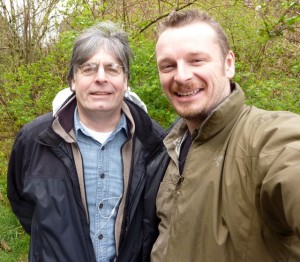
Earlier this month Steve Scher, host of the popular NPR-KUOW radio show ‘Weekday’ joined me in the field to talk bears. Steve was piecing together a story about the bears of Washington and wanted an opportunity to learn about some of the work GBOP and our partners do on the ground. We met at Tradition Lake near Issaquah and within minutes I was able to show him some fresh bear sign! A beautiful example of a tree stump destroyed by a black bear that was searching for grubs. This forest is a great example of the quality habitat that can be found on the outskirts of a sizeable town like Issaquah, and where conflicts between bears and people can occur. These conflicts usually revolve around non-natural food attractants. A bear in a backyard is just like a dog begging at the dinner table – one reward and he’ll be back for more. The trouble is, once a bear is “food-conditioned” by tasting high-calorie foods like garbage, sunflower seeds, and compost, it is a hard habit to break. As we scoured the forest for bear clues I shared some of these thoughts with Steve who enthusiastically recorded them for his show.
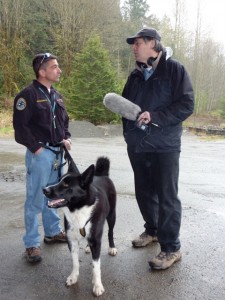
I was excited about Steve’s approach as he was really trying to assess the future of grizzly bears and other large carnivores in Washington State. With fewer than 20 grizzly bears in the North Cascades, their future does not look bright without human intervention (an augmentation of bears from another area would be needed). In contrast, in 2008 wolves made a natural return to the Cascades for the first time in 80 years, and given half a chance, their numbers will increase along with their range. Black bears are doing pretty well in the forested ecosystems of Washington – estimates suggest there are around 20,000 in our state.
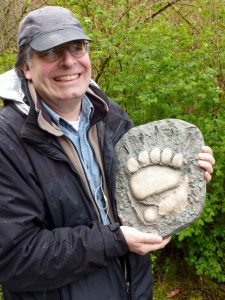
What’s good for black bears is good for grizzly bears too, and with that in mind GBOP is always thinking about pragmatic ways for humans and bears to coexist. One of the programs we love is the work of Rich Beausoleil and Bruce Richards, both of whom are carnivore biologists with Washington Department of Fish and Wildlife. They are on the frontline of working with bears and people to ensure safety and understanding – for both species! They use Karelian bear dogs to help keep black bears (and cougars) from getting into trouble near human property. This incredible approach to wildlife management is quite something to witness so I introduced Steve to Rich and Bruce that same afternoon. He recorded the sound of a bear being released from a culvert trap with the specially trained Karelian bear dogs in hot pursuit. The recording on the radio sounds pretty dramatic to say the least, but it is all in the bear’s best interest. Instead of capturing a bear at the location where it has gotten into trouble and translocating it (only to find it later return) the new approach (made possible by the use of these dogs) is to release the bear actually right there – in the very place it is finding itself in trouble. Once the culvert trap door opens, the bear bolts out, and the crazy commotion of noise and dogs ensures that the bear will not be back for more! “Tough love” as Rich says. But it works. Steve got a real kick out of meeting Cash and Mishka, the two dogs owned by Rich and Bruce. They are among the best wildlife ambassadors out there.
Next stop was an interview with Cathy Macchio, an incredible lady who has taken it upon herself to arm her neighborhood in the Issaquah Highlands with all the information needed to live peacefully in bear habitat. She has worked tirelessly to help bears and people and we are honored to now welcome Cathy to the GBOP team.
On Monday, Steve invited Rich, Scott Fitkin (US Forest Service wildlife biologist) and myself back to the studio for a live show about bears, cougars and wolves. The show became a great overview of Washington’s carnivore heritage. You can hear the podcast here: http://www.kuow.org/program.php?id=20076
Our thanks to Steve Scher and everyone at NPR-KUOW for supporting our work by helping to spread the word!
Chris Morgan
Co-Director, GBOP

